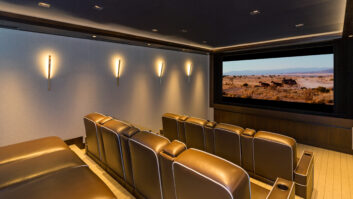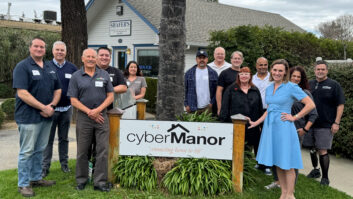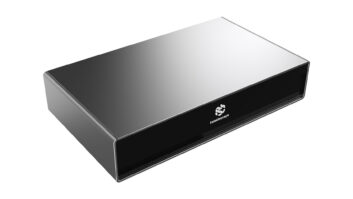Despite the doldrums in the consumer electronics retail market recently, one category produces standout–if not record–sales each month: DVD. At the same time, however, as the torrid sales pace continues, the DVD format also continues to generate controversy, as it has done since its inception.
For those who are new to the game, it is worth reminding that the current DVD format was born as the result of the merger of two competing optical disc format proposals. Similar, though just different enough to be non-compatible, the original Sony/Philips MMCD format merged with a format spearheaded by Toshiba and the rest of the consumer electronics world to create today’s DVD.
The sales results show that the consolidation was a good move, but here we are again, with what, in some cases, are the same groups taking sides yet again. The critical difference is that in the case of the original DVD formats there was enough of a truce that neither format was released to the marketplace. Thus, all existing DVD players are compatible with all discs. Today, in at least two cases involving advanced DVD formats, the sparring has already begun, and you are right in the middle of it.
Perhaps the most visible of the current “beta vs. VHS” format battles is the struggle for dominance between DVD-Audio and SACD to capture the market for high-resolution, optical disc-based digital audio playback. Both do basically the same thing: deliver high quality audio, but they do it in ways that are just different enough to make the formats incompatible.
To make life complicated, we not only have some manufacturers supporting one format and other manufacturers supporting the other format while some are offering dual-format machines, there is also a division in the software ranks. On the software side, Sony’s record labels support only SACD, Warner and BMG labels support only DVD-A, while Universal and EMI have their feet in both camps. Even for the labels that issue in both formats, however, to date the release of individual titles has been in one format or the other, not in both.
That leaves us in an interesting standoff, with slightly more SACD titles in the market, but with more brands offering more models of DVD-A players. To some extent this has the potential to complicate matters for you if a client has brand loyalty in one direction, but desires to listen to high-resolution discs that are only available in a format their favorite brand does not support. Put another way, it appears unlikely that a title will be available in both formats, unlike the “good old days” when you could find the same title in cassette, 8-track, vinyl and CD.
What’s a system designer to do? For the complete system, you can always buy two players, one for each format. Of course, that presents other problems, including the need to connect 5.1 analog outputs to the processor or receiver when most have only one set of “direct” input jacks. The alternative is to go for one of the increasing number of so-called “universal” players that will handle both formats.
Indeed, that is the direction you may predict this will go in the mid- to long-term. The fearless RS prediction is that like 33 1/3 and 45 RPM records of the past, SACD and DVD-A will co-exist; both will proceed in parallel with the ultimate success of one or the other based on the artists and titles appearing on one format, not the technical details of the format itself. Over time, more and more players will be dual-format, making the whole issue moot.
There is another format battle underway in the DVD world that may or may not have a similar “one size fits all” ending–the race to win supremacy as the leading recordable DVD format. This has been covered here before, and in some respects, the news is that little has changed.
There are still three recordable/re-writeable formats: DVD-RAM, DVD-RW and DVD+RW. While each records video on a DVD-like disc, they use different blank discs, which are not compatible from a machine in one format to a machine in the other. “RAM” has the advantage in terms of number of record/erase/re-record cycles and it is designed so that manufacturers may use it to offer time-shift functionality with the drive playing one track and recording another in a different location on the disc at the same time. The downside is that it is not compatible with the vast majority of DVD players and DVD-ROM drives now in the market. That’s a big problem when the client wants to copy some camcorder footage to a DVD and send a disc with their child’s first steps, piano recital or Little League triumph to the grandparents.
Fighting the backward compatibility issue, both the “dash” format (DVD-R/RW) and the “plus” format (DVD+R/RW) claim 90 percent playability on existing DVD machines, but they use different discs and their major incompatibility is that “-” discs are said to not be able to play in “+” machines, and vice-versa. Otherwise, things are about the same in terms of blank media costs and functionality.
Thus, the question becomes one of whether you should recommend one format or the other, or avoid the product category at all? To some extent, you have to evaluate the client’s needs. Do they want to use the DVD recordable as a time-shift device with full broadcast pause and PVR like functions? Do they need playback compatibility with a DVD-RAM camcorder? Those folks will want a RAM product. Is playback on existing DVD machines important? Then you flip a coin and go with “-” or “+”. Is the client unwilling to take a chance between two formats, fearing that one might not survive, leaving them without a ready source of blank discs? Some time this month you’ll be able to hedge your bets with Sony’s RDR-GX7, which is able to record both -RW and +RW discs, as well as write-once “R” discs.
A bit confusing, but perhaps it is a bit early in the game. The reason for that is while the DVD format is certainly entrenched in the consumer market, and with DVD recordables becoming a factor as a replacement for the VCR becomes something that is closer, rather than further away, another DVD related format issue clouds the picture: what format will be agreed to for use as the carrier for HD on DVD? In turn, that may influence the decision over which recordable format, if any “wins”.
Taking a step back for a moment, there are two main ways that the form factor and basic technology of a five-inch optical disc may be used to store enough data so that a two-hour movie takes up no more than one side of a disc. One way is to use advanced compression technologies that “squeeze” the digital signal down considerably more than today’s MPEG-2 so that you may use the same red-laser based technology as today’s DVD players and still achieve HD nirvana.
This is certainly do-able, and a number of compression schemes are being promoted to the studio community as being capable of doing the job. Among them are the H.264 format, various incarnations of MPEG-4, Microsoft’s Windows Media 9 technology, Real Audio’s latest codecs, advanced versions of MPEG-2 and compression technologies from start-up companies such as Pixonics. Having seen demonstrations of all of these, and more, it should be noted that any of the possible options can be tweaked to do the job, but the question is which one presents the combination of quality, ease of encoding, backwards compatibility and licensing cost that wins over the key home video executives. At the moment, any one could be selected, but politics must also be considered along with the technical and financial concerns.
This type of solution has the appeal of not requiring new pick-up hardware, though decoder chips would have to be developed. Yet, it would make it easier to get the machines into production, and little or no alteration would be needed to the facilities that manufacture the packaged media DVD movies that we all buy and rent. That, too, is a key decision point for Hollywood.
This first approach is a reasonable one, but hold your thoughts on it until the idea gains formalization and acceptance from the studio crowd. It has very little visibility at this point within the general public, which is not the case for blue laser based formats; aggressive BluRay publicity has spurred some notoriety in the general press.
Where the first technique uses standard DVD discs with advanced compression, blue laser formats do the opposite by squeezing more of the current MPEG-2 (in the HD configuration) data onto a disc. To make life interesting, there is a format battle within the format battle here, as two competing formats have been proposed. One, BluRay, has been demonstrated by many of the system’s supporters, which include Sony, Matsushita, Samsung and others.
In fact, Sony will soon be selling production versions of a BluRay machine for the equivalent of $3,850 in the domestic Japanese market. Don’t let that lull you into thinking it is going to arrive here soon, however. That model has a built-in tuner for the BS satellite system in Japan, but is NOT compatible with US HD transmission systems. Blank discs won’t be cheap at about $30 each.
An alternative is the Advanced Optical Digital (AOD) system, proposed by Toshiba and NEC. It also uses a blue laser, albeit with a smaller numerical aperture, but its key advantage is the use of a disc structure whose layer size is identical to that of the current DVD format. The importance of this is that while the disc masters for AOD would need to be made on new machinery, the investment that replication facilities have made in pressing and stamping lines would remain useful.
Differences aside, both formats are recordable, so presuming that other issues such as the availability of encoders and approved, secured, connection links to off-air, cable or satellite programming are available (think 1394 with DTCP or DVI/HDMI with HDCP here), blue laser has the potential to be an HD recording and playback format.
So here we have two races, each with a race nested inside! Which will be the choice of the studios: ultra-compressed data red laser or blue laser? Then once a format is selected which version of the format will be used?
It’s a bit too early to predict the winner here, but based on the hallway talk at the recent NAB convention, undercurrents indicate that we may see both formats used. Red laser with compression will provide a quick, easy and relatively low cost point of entry for high-definition DVD. After all, the components are, for the most part, available and proven, with software, rather than hardware the point where refinement and new components are needed. You may see it within the next eighteen months.
Does that mean that blue laser will miss? Probably not. The thinking is that it is a good idea, but simply too expensive. There is every reason to suspect that red laser might serve as a “warm-up” while the cost of blue laser is brought down to more affordable levels. Add in a dual-head red/blue laser combination and you even regain the backwards compatibility with the ever-growing library of current DVD discs, and even the red-HD discs that may have been sold in the interim.
There is one ultimate combination: marry the native capacity of a blue laser format with heavy-duty compression and you get an incredible format that could record just about anything, and lots of it! We haven’t heard that type of format proposed yet, but who knows.
Wait. Did we say a format that would record anything? A nice idea for blue-sky thinking, but lest your clients get too confused, it should be noted that as yet no recording format has been approved, or even proposed that would enable in-home recording in the DVD-Audio or SACD formats. This is possible, but for the time being it may be too problematic for a number of reasons.
Most critically, it is hard to imagine the music labels permitting home products that would allow replication of these master-quality discs. The pirate potential may well be too great. On a more practical level, there is still no widely approved, standardized and available digital link for that is permissible for both DVD-A and SACD, and again, content protection considerations might mean we won’t see it for some time.
Without a digital input, high-resolution, in-home digital audio recording from analog sources, or even current CDs or MP-3s, will require advanced encode or transuding chips with horsepower and software that is not yet available. As with the similarly MIPS intensive requirement for HD encoders, this isn’t something that is impossible, but it is something that is difficult and, at the moment expensive. Only time will tell if the market will demand it, and Moore’s law will make it possible.
At the end of the day, it looks as though we have a basket full of advanced DVD-based audio and video formats on the cusp of acceptance. Each has great potential, but in each category there are internecine battles underway.
Unlike the many format battles of the past, however, in each of these cases we may well find that once the inner format discussions are settled, we will see parallel acceptance of competing versions of the same technology. In an industry where format battles go all the way back to the dawn of the electric age when Edison’s DC system competed with Tesla’s AC system (backed by Westinghouse) in the “Battle of the Currents”, through the 8-Track vs. cassette and beta vs. VHS battles where no combined machines were possible, to 33 1/3 vs. 45 records or AM vs. FM where unified products did solve the problem, wouldn’t it be nice not to have a format war? That’s something we can all hope for, something for which we may even wait.
Michael Heiss ([email protected]) is a technology and marketing consultant based in Los Angeles, California.







